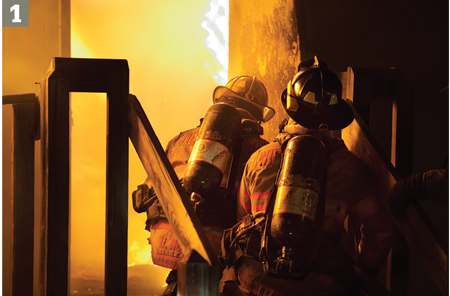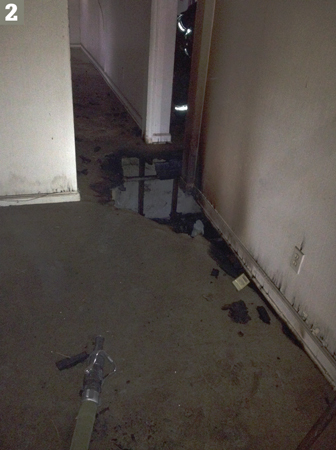By Nicholas A. Martin
In the academy, we learn early that we will spend little time on our feet inside the fire, that to improve visibility, stay out of heat, and so on, we need to get low, stay low, and move low. But with this important, almost obvious, concept often comes one of our first bad habits: moving on our hands and knees. Moving on our hands and knees is an awkward and a restricting body position for many reasons. Most of these problems can be solved by “duck-walking” or moving with one knee down and one foot out. Let’s discuss these body positions in connection with some fireground considerations.
 |
| (1) The time to “get low” comes early. [Photo by Battalion Chief John Turner, Wichita (KS) Fire Department.] |
Visibility
Recently, I was the engine officer for a first-due to a house fire. As we moved in with the line, I was a few feet behind the nozzleman and pulling some line with me. The fire was in a fully involved kitchen on the first floor. As we moved from the living room down a hall to the kitchen, the nozzleman moved almost instinctively straight toward the kitchen, which was the obvious source of fire. He was on his hands and knees with the pipe in one hand. I was duck-walking. What he couldn’t see was that the fire was rolling out of the kitchen and coming down the hallway over our heads, back toward the living room. I got his attention, and he quickly hit the hallway ceiling and then darkened down the kitchen.
Fortunately, nothing bad happened, but if neither of us had noticed, the fire could have easily lit off behind us or could have gone up the open interior stairs and extended to the second floor, perhaps cutting off the truck crew who was up there searching. When we are on our hands and knees, we can see only the floor and a little bit in front of us. Any attempt to see above us would result in our helmet hitting our bottle. As we know, we need to be keeping a “six-sided view” of our operating environment, and conditions at the ceiling level can be very telling of the environment in which we are operating.
Points of Contact
Moving on your hands and knees requires that you have both hands and both knees on the ground. There are a couple of issues with this. In the fire scenario above, I was duck-walking with a halligan bar in one hand and pulling hoseline with the other. Doing this in a crawling situation would have been very challenging and less efficient. I likely would not have been able to effectively manage both.
 |
| (2) If your center of mass encounters a hole or a weak spot, it will be very difficult to recover. (Photo by Craig Hacker.) |
Another problem occurs in a tough, hot fire. It’s not uncommon for the floor to become very hot, particularly if you’re operating above the fire or if the carpet begins to melt/burn. Many firefighters have suffered knee burns resulting from their body weight compressing their turnouts on their knees on a hot floor. Moving in a duck-walk, the soles of both our feet will be on the ground; they are much better equipped to handle a hot floor. Moving in a one-knee-down, one-foot-out position allows us to alternate knees, which provides some relief should it get too hot.
Center of Mass
We all know how important it is to check to make sure that the floor in front of us is intact before putting our weight on it. Imagine you are crawling on your hands and knees and there is a weak spot ahead on the floor that may be concealed by carpet. If you are crawling, your torso (the heaviest part of your body) will be the first to reach the weak spot in the floor, and you will fall head-first into the hole. With all this mass through the hole, it will be challenging for you to self-rescue or for others to pull you out. If using the duck-walk, you stand a greater chance of finding a weak spot before the center of mass goes over it, and if you should begin to fall through the hole, your lighter lower body will go through first, and your arms will be in a better position to stop your fall and enable you to self-rescue.
Whether you’ve been on the job for a few minutes or only have a few minutes left on the job, take a minute to think about how you move when it’s time to get low. It’s undisputed that we should “get low” inside the fire environment. What we must also consider is the safest way to do this.
NICHOLAS A. MARTIN is vice president of and an instructor for Traditions Training, LLC.

